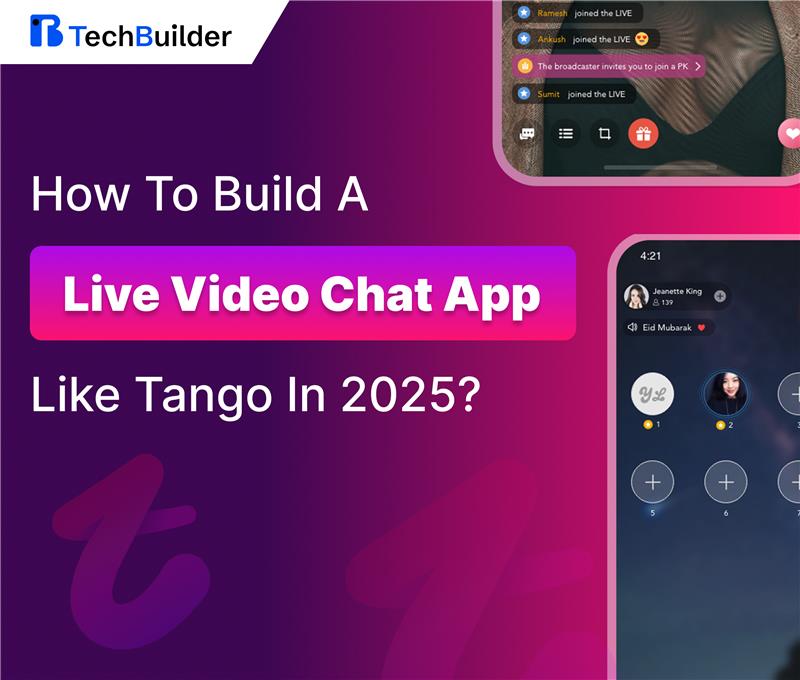Consider how frequently you’ve jumped on a fast video conversation with pals, attended a remote meeting for business, or communicated with family members – who live far away. Video chat has become an integral part of our everyday lives, no longer a “nice-to-have” but almost a requirement. In fact, more than half of mobile users say they prefer face-to-face interaction through apps over simple texting or voice calls.
By 2025, live video chat apps such as Tango, Zoom, and Houseparty are no longer mere communication devices. They have evolved to become platforms of connection, learning, business, entertainment, and even health.
If you ever wondered how to develop a video chat app of your own, this guide takes you through all the steps — from essential features to the current technology stack.
Why Build a Video Chat App in 2025?
The popularity of video chat apps is greater than ever. Statista estimates that mobile video calls are expected to reach more than 5.4 billion users globally by 2025. Several trends contribute to this fast growth:
- Remote work is here to stay – as firms embrace hybrid and flexible work cultures.
- Telemedicine has turned into a mainstream service, with patients embracing virtual consultations over in-person visits.
- Education is adopting online learning, with live classrooms and group video calls keeping the students on their toes.
- Live video chat capabilities are rapidly being added to social networking and dating apps – in order to improve engagement and retention.
For both startups and corporations – developing a video chat app in 2025 requires more than just keeping up with the times. It is about creating differentiated value in a rapidly developing market.
Do You Want To Create Your Own Video Chat App Like Tango? Let’s Build It Together
Key Features of a Successful Video Chat App
When you are designing a video chat app, the correct set of features is what makes the difference between an app that users adore and one that they delete after a few uses. Let’s discuss the most important features in detail:
- One-to-One Video Calls
At the core of any video chat product is the ability to place smooth, one-to-one video calls. This capability is fundamental because single-person conversations are usually the most frequent use case for users — whether it’s checking in with a friend, talking with a doctor, or negotiating a business idea. To create a video chat app that users actually adore, instant connectivity, crisp audio, and high-definition video are absolute must-haves. One millisecond of delay or sub-par quality can annoy users, so making seamless one-to-one connections should be the number one goal.
- Group Video Calls
Private calls are crucial – but the magic is really happening when individuals are able to connect in groups. Group video conversations are extremely useful for everything from workplace conferences and web seminars to virtual family reunions and social activities. An effective app must accommodate several participants at the same time while maintaining high levels of reliability as the user base expands. If you’re developing a video chat software like Tango or Zoom – this is an essential feature, as group calls have become the norm in both professional and social communication.
- Messaging & File Sharing
A modern video chat app is more than just face-to-face interactions; it also promotes teamwork. Users may instantly share notes, images, links, or important documents – without leaving the platform – thanks to the integration of text messaging and file-sharing capabilities in the call window. This reduces friction and centralises information – making it ideal for corporations, distant teams, and students. To build a video chat app feel whole, chat and file-sharing features are now indispensable.
- Screen Sharing
Screen sharing has become one of the most useful features in video chat software within a short period of time. It’s either for presenting a client, instruction in an online class, or fixing a problem for a friend, showing your screen in real-time significantly increases clarity and productivity. For companies, it’s an invaluable resource, and for teachers, it increases online study so much more interactively. Any app that wants to rival market giants needs to include a seamless, secure screen-share feature.
- Interactive Add-ons (AR & Filters)
In addition to functionality, today’s user wants play and interactive features in his or her video calls. Augmented Reality (AR) filters, stickers, reactions, and virtual backgrounds are features – that provide an added layer of creativity and playfulness. They’re particularly popular with younger users on platforms such as Snapchat or Instagram – but even more professional platforms such as Zoom have caught up with virtual backgrounds. If you’d like to create a video chat application that has both social and professional users attracted to it – interactive add-ons can differentiate you and lead to more engagement.
- Push Notifications
A sometimes underestimated but important retention feature is push notifications. Users receive timely reminders about future appointments, missed calls, and app upgrades. Without it, users may miss important interactions and finally exit the service. Push alerts help to increase user engagement, reduce drop-offs, and keep your video chat service relevant in users’ daily lives.
- End-to-End Encryption
With increasing anxiety around data breaches and internet security, end-to-end encryption is now the norm to expect. Users need to have assurance that their conversations are secure and private, whether it’s a sensitive business conversation or a private chat. Robust encryption not only fosters trust but also ensures your platform is compliant with laws such as GDPR or HIPAA (for medical apps). If you are going to build a video chat app in 2025, security must not be an afterthought — it must be a building block.
A survey conducted by Owl Labs reported that – almost 96% of staff stated that video conferencing had greatly enhanced connectivity across remote teams.
Key Features of a Video Chat App
| Feature | Why It Matters | Example Use Case |
| One-to-One Calls | Core private interaction | Doctor-patient consultation |
| Group Video Calls | Multi-user collaboration | Team meetings, virtual events |
| Messaging & File Sharing | Enhances teamwork | Students sharing notes |
| Screen Sharing | Boosts productivity | Business presentations |
| Interactive Add-ons | Engages younger users | AR filters, stickers |
| Push Notifications | Improves retention | Missed call alerts |
| End-to-End Encryption | Builds trust & security | Confidential business chats |
Technology Stack for Building a Video Chat App
Your video chat app’s scalability, durability, and long-term performance – are determined by the technology and tools that powers it. Here’s a breakdown of the most common tech stacks for developing a video chat app:
Frontend – User Interface
- React Native or Flutter for cross-platform applications.
- Swift for iOS and Kotlin/Java for Android
- They ensure your app is aesthetically pleasing and runs smoothly across devices.
Backend (Server & API Management)
- Node.js, Django, or Spring Boot
- These take care of all background operations, connections, and data transfer.
Real-Time Communication
- WebRTC (industry standard for real-time audio/video).
- Socket.IO for data transfer.
- Third-party SDKs such as Agora or Twilio – if you prefer faster development.
Cloud Infrastructure
- AWS, Google Cloud, or Firebase.
- They enable apps to scale with ease as user demand increases.
Database
- Use MongoDB, PostgreSQL, or MySQL to securely manage user data and chat logs.
Security Layer
- TLS/SSL encryption, two-factor authentication, and GDPR/HIPAA compliance – important for healthcare apps.
Your stack decision will be influenced by the type of app you want to build – your budget, and – the size of your target market.
Steps to Create a Video Chat App like Tango
Creating an app like Tango seems daunting, but dividing it into steps simplifies the process. This is how most businesses do it –
- Research & Strategy
Get to know your audience — whom are you creating it for? A social networking application, a health application, or an enterprise application? Clearly define the purpose of your app.
- Feature Planning
Begin with the basics (one-to-one calls, group chat, messaging). Add later advanced features depending on feedback. This does not – overcomplicate the initial launch.
- Design (UI/UX)
Your app has to be user-friendly. Clean layouts, clear icons, and seamless navigation -keep users longer and coming back often.
- Select Tech Stack
Choose the proper frameworks and APIs. WebRTC is the de facto choice for real-time video, and APIs such as – Agora or Twilio accelerate development.
- Construct MVP (Minimum Viable Product)
Ship a lightweight version in a hurry to validate real-world performance and gather feedback.
- Testing & QA
Verify that the app is smooth across varied network conditions – is multi-device compatible, and is secure. Latency, crashes, and privacy can be deadly to user trust.
- Launch & Scale
After the MVP is a success, roll out updates, introduce features such as AR filters or monetization schemes, and scale according to market demand.
By doing this, business owners can develop a video chat application that’s not only practical – but also scalable and future-ready.
Dilemmas in Developing a Video Chat App
Although creating a video chat app is an intriguing idea, the truth is that it is accompanied by great challenges. Solving them early on saves much trouble down the line.
- Scalability Problems – When you initially create a video chat application, it will be alright with 100, even 1,000 users. But as your user base increases, supporting large numbers of concurrent video calls puts pressure on servers. A badly designed backend will result in crashes or screen freeze, which is why scalability planning cannot be skipped.
- Low Latency – No one wishes to observe lips articulating two seconds after the voice. Even a 200–300ms holdup feels jarring in real-time communication. It is necessary to employ technologies such as – WebRTC, 5G networks, and optimized codecs in order to make video conversations as real-time-oriented as possible.
- Security & Privacy – As cyberattacks increase in number, users look for end-to-end encryption and regulation compliance such as GDPR, HIPAA, and SOC 2. Unless you focus on security while building a video chat app, users simply will not trust it.
- Cross-Platform Compatibility – Your users can join from Android, iOS, or a web browser. Providing an equivalent experience across all platforms – is a technical issue, particularly in terms of video resolution and device performance.
- User Experience (UX) – No one wants just a functional app; they want one that is easy to use and engaging. Even the greatest features won’t be relevant if users find the user interface cumbersome or confusing.
As per Qualitest, 88% of users will leave an app after only two negative experiences. This implies that performance and design are as vital as each other – when you design a video chat app.
Challenges in Video Chat App Development
| Challenge | Why It’s Critical | Solution |
| Scalability | Handles more users without lag | Cloud + load balancing |
| Low Latency | Real-time communication | WebRTC + 5G support |
| Security & Privacy | Builds user trust | End-to-end encryption |
| Cross-Platform Support | Ensures wider adoption | Native + cross-platform dev |
| User Experience (UX) | Retains users long-term | Clean, simple UI design |
Curious About How Much It Will Cost To Build A Video Chat App? Let’s Dig In
How Much Does It Cost to Create a Video Chat App?
One of the most common queries that businesses ask is, “How much will it cost to build a video chat app?” The truth is that there is no single answer. Costs vary depending on several factors:
- Feature complexity – A basic MVP (minimal viable product) that includes one-on-one video calls and messaging might cost $10,000 to $30,000. However, if you require more advanced features such as group calls, AI-driven filters, and live streaming, expenses can quickly cross over $30,000–$50,000 or $50,000+.
- Platforms – Creating a cross-platform video chat application for iOS and Android requires more time and investment – than creating something for a single platform.
- Tech Stack & APIs – Using third-party SDKs (such as Agora, Twilio, or Vonage) accelerates development at the expense of recurring subscription costs. Developing a whole solution custom-built costs more upfront but less over time.
- Design & UX – Spending on a user-friendly, modern UI/UX design costs more initially but reduces churn and increases retention.
- Developer Location – Recruiting developers in North America or Europe normally ranges from $80–150/hour, with highly skilled teams in Asia or Eastern Europe offering $25–60/hour.
Companies should pay between $30,000 and $50,000+ for a simple app with complete functionalities.
Estimated Development Costs
| App Type | Approx. Cost Range |
| Basic MVP (1-to-1 Calls) | $10,000 – $30,000 |
| Mid-Level (Group Calls, Messaging) | $30,000 – $50,000 |
| Advanced (AI, AR Filters, Streaming) | $50,000+ |
| Ongoing Maintenance | $2,000 – $5,000/month |
Future of Video Chat Apps in 2025 and Beyond
Video calling applications are now more about bridging faces on the screen. The future holds promising new trends that will revolutionise how people connect, learn, and work:
- AI-Powered Features – Artificial intelligence will enable real-time translation, meeting transcription, and noise reduction to improve cross-border communication. Picture talking English while your co-worker hears the translation instantly in Spanish.
- AR/VR Experiences – The metaverse is still developing, but virtual meeting spaces and avatars are going mainstream. Next-generation video chat applications might allow people to interact within a virtual 3D space rather than looking at flat screens.
- 5G Expansion – As 5G networks go live across the world, look forward to ultra-low latency, HD-quality video calls even in public places such as concerts, conferences, or big classrooms.
- Integration with Other Services – Apps tomorrow will not be isolated tools. They will be integrated into education platforms, telehealth solutions, e-commerce stores, and social media apps, allowing smooth interaction across sectors.
As per Fortune Business Insights, the global video conferencing market will be worth $60.17 billion by 2032, with a CAGR of 7.8%. That is to say that the chance of developing a video chat application that excels is greater than ever before.
Conclusion
By 2025, video chat apps will be more than just a means of communication; they will be a part of everyday life. Whether it’s remote business, online study, or connecting with relatives all around the world, video chat apps can transcend gaps in ways that texting or phone calls never could.
If you’re intending to design a video chat software, focus on three crucial features:
- Features that are most important to your audience.
- Technology that provides both security and low latency.
- User experience that brings them back.
Creating a video chat app isn’t all about keeping up with the times.It is about creating a platform that allows people to interact and collaborate in an increasingly digital world.





































































